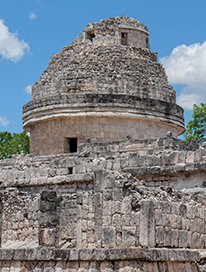25.1 Exploring the Solar System
Reading Focus
Key Concepts
 How are the geocentric and heliocentric models of the solar system different?
How are the geocentric and heliocentric models of the solar system different? What keeps the planets in orbit around the sun?
What keeps the planets in orbit around the sun? What bodies make up the solar system?
What bodies make up the solar system? How is the solar system being explored today?
How is the solar system being explored today?
Vocabulary
geocentric
heliocentric
ecliptic plane
moon
astronomical unit
space probe
Reading Strategy
Comparing and Contrasting After you read, compare the geocentric and heliocentric systems by completing the table below.
|
Location of Earth |
Location of Sun |
Developer(s) of Theory |
|---|---|---|---|
Geocentric System |
Center of universe |
a. |
b. |
Heliocentric System |
c. |
d. |
Aristarchus, Copernicus |
For thousands of years, people have used the sky to track the pas- sage of time. Farmers in ancient Egypt watched for the first morning appearance of the bright star Sirius to know when to prepare for planting. Stonehenge, in England, consists of a group of large stones set in a circular pattern long ago. The locations of certain stones mark the spots where the sun rises or sets on the longest and shortest days of the year. About 1000 years ago in Central America, the Mayans built observatories such as the one shown in Figure 1. They used their observations to develop calendars and even predict astronomical events.
Models of the Solar System
Ancient observers noticed that most objects in the sky seem to be in a state of slow but steady motion. Every day the sun appears to rise in the east and set in the west. The moon, too, rises and sets every day. Similarly, the stars move across the sky in a fixed pattern.
Camp out for a few nights and you'll notice, as the ancients did, that the stars appear to circle around a fixed point in the sky. In the Northern Hemisphere, the stars circle around Polaris, the North Star. Most ancient people concluded that Earth was stationary and the sun, moon, and stars moved around Earth.
Ancient observers noticed that a few bright starlike objects seemed to wander slowly among the fixed patterns of stars. These objects were called planets, from the Greek word for “wanderers.” Besides Earth itself, the ancients knew of the five planets that can be seen with the unaided eye: Mercury, Venus, Mars, Jupiter, and Saturn.
Figure 1 The Mayan ruin of El Caracol, also known as “The Observatory,” is located on the Yucatan peninsula. It is thought that the Mayans used El Caracol for astronomical observations.






